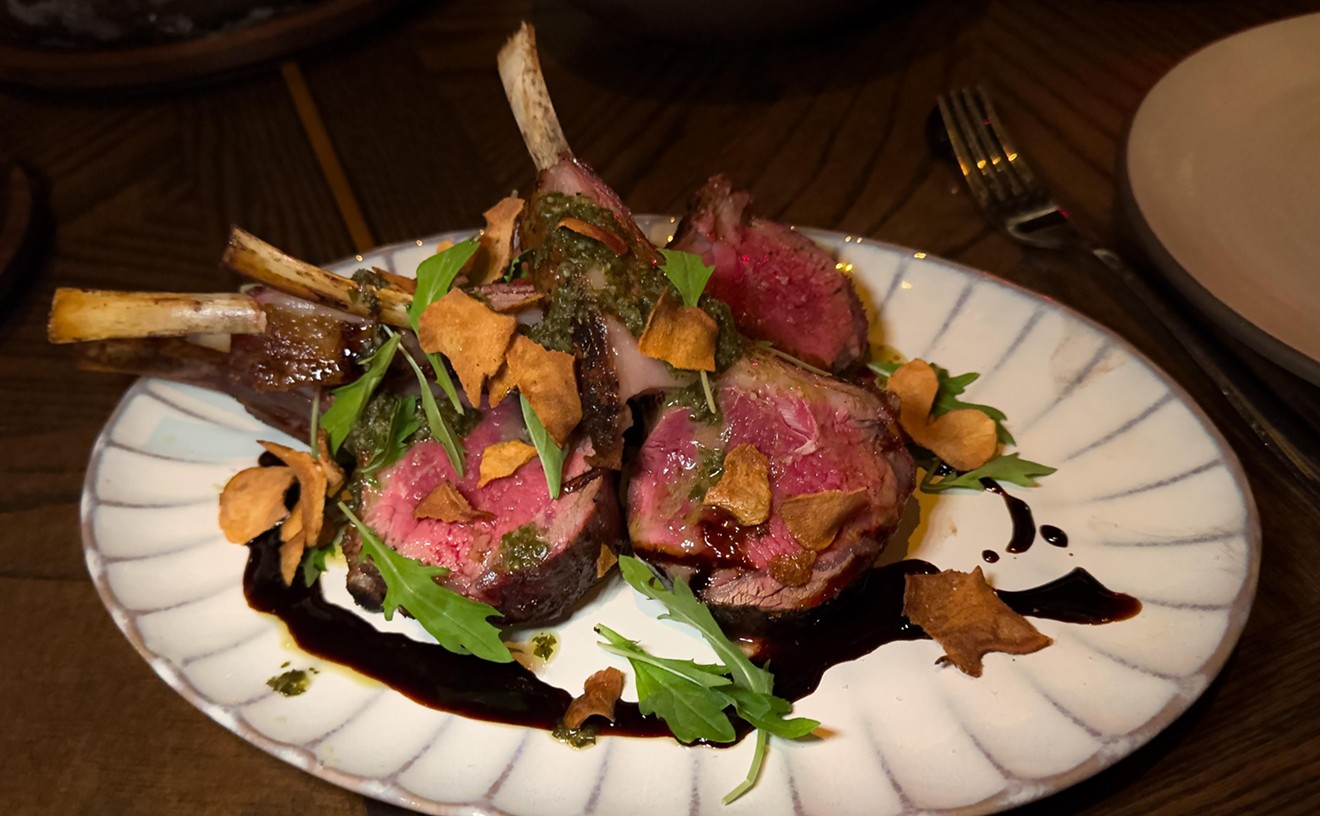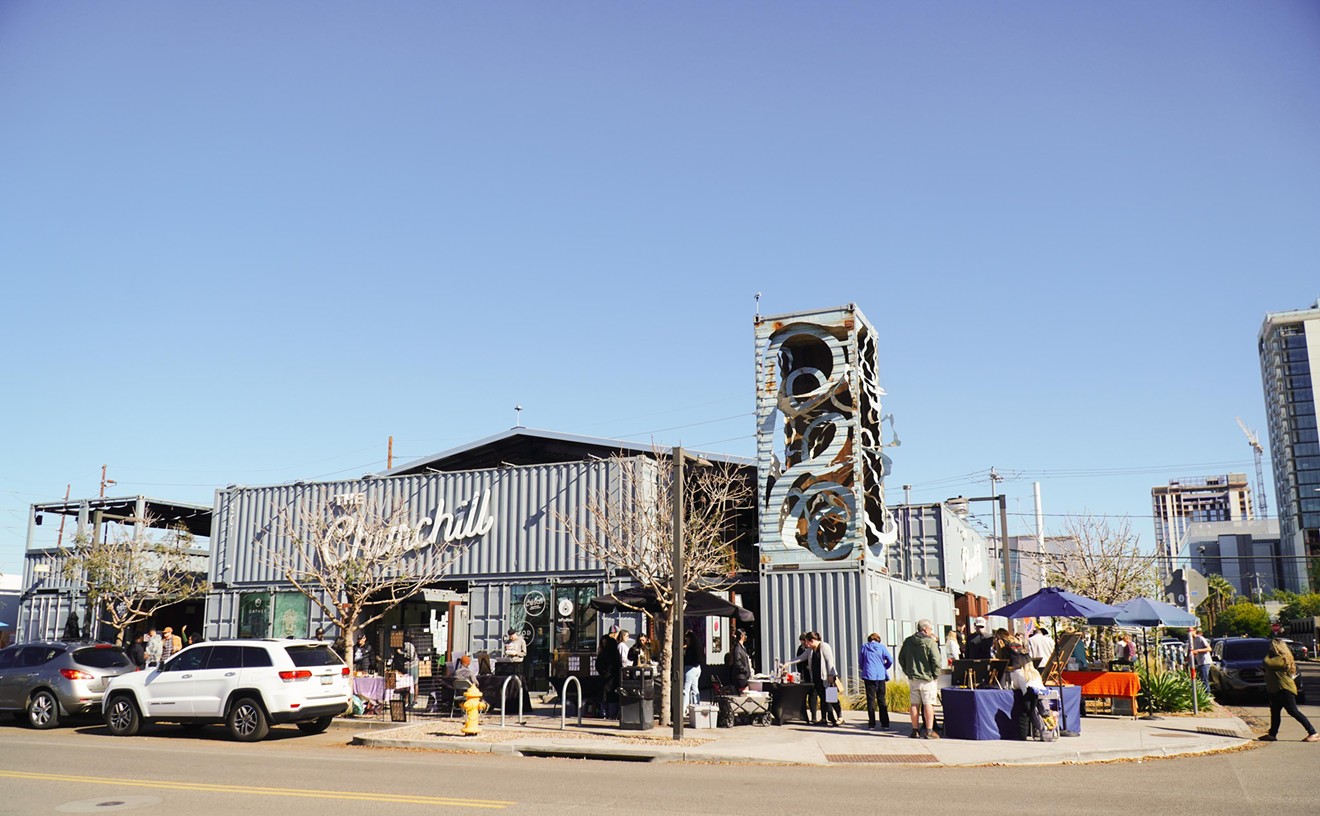Who could conceive of butchering poor Rudolph the Red-Nosed Reindeer?
Payton Curry. And he's come up with fancy ways to show off the gastronomic possibilities of feasting on Santa's adorable sidekick.
A couple of weeks ago, when the cheeky, curly-haired executive chef of Tempe's chic Caffe Boa announced he'd be serving a six-course reindeer tasting menu for the holidays, the restaurant was bombarded with phone calls.
Local and national media (including yours truly, along with MSNBC, Carson Daly, and Bloomberg) were all over the story, and some interviewers even bluntly told Curry that they thought his decision was in poor taste.
Turns out, the meat of choice is actually caribou, the North American relative of reindeer. And although it seems innocuous compared to the sort of gag-worthy things that TV host Andrew Zimmern eats on his popular Travel Channel show Bizarre Foods — snake, guinea pig, and all manner of icky-looking offal — caribou shocked people all the same.
That's because even though caribou is in the fine print, Caffe Boa's press release and menu deliberately call it reindeer. It's one thing to serve exotic meat, but downright outrageous to sell it as a Christmas mascot on a plate.
This smart-ass clearly knew he was stirring the pot.
Controversy isn't new to Curry. On Easter, he pissed off a lot of pet owners and little kids by putting rabbit on his special holiday menu. It was free-range, all-natural rabbit, he argued — not domesticated bunnies — and rabbit is often on the regular menu at Caffe Boa. Nevertheless, that didn't quell the uproar over him killing the Easter Bunny.
Well, the theme was Alice in Wonderland, but everyone got the bunny connection anyway.
"What did Alice do once she found The White Rabbit?" read the press release. "Why, she ate him, of course. And you can, too, this Easter at Caffe Boa."
Curry actually did the rabbit menu a couple of years earlier, albeit in a more low-key way, when he was the executive chef at now-defunct Digestif in Scottsdale. At the time, owner Peter Kasperski didn't give his approval, but Curry went ahead and served Easter Bunny anyway. With no promotional push and just a bit of insider word of mouth, Curry's special sold surprisingly well.
Rabbit will definitely make an Easter encore at Caffe Boa, Curry insists; he's also considering a heart menu for Valentine's Day.
"And for the gentlemen, we'll be serving beaver," he adds, perfectly deadpan, before cracking a smile. "That kind of shit I think is fucking hilarious."
Call it a publicity stunt, but it's also brilliantly effective marketing. And it was Curry's own idea. Look past the word "reindeer" — and inevitable thoughts of Rudolph — and you'll find a high level of sophistication on Curry's Christmas tasting menu. It reads like something you'd more likely come across in gourmet meccas like San Francisco or Portland than in play-it-safe Phoenix: caribou tartare with pickled quail eggs, caribou tongue bruschetta with pickled watermelon radish and horseradish crema, caribou cotechino sausage with red lentils and quince mostarda, and so on.
While I didn't get to sample any of it before my deadline, I imagine it will be as intriguing as what I ate at Caffe Boa a month ago — luscious Mangalitsa headcheese (made from prized heirloom pigs); duck confit draped in a translucent blanket of lardo (cured pork fat); delicate Tajarin pasta with butter-poached scallops and Meyer lemon-Prosecco sabayon.
So what does Curry get out of carving up Rudolph? And what — if anything — does it mean for the Phoenix food landscape?
"We're having fun — I have to do something to keep people entertained," he says.
Really? On one level, I get it — customers can be fickle, and it takes work to stay in the public eye.
But I think Curry himself is the one who wants to be entertained. He's talented, passionate about food, and perhaps a bit frustrated with the local restaurant scene, where risk-takers come along far too rarely, and the recession has made many restaurants retreat onto predictable culinary territory. I wonder whether he'll stay in town long enough to bring reindeer back next year.
"I don't wanna give up on Arizona," says Curry, who's been here three years. "If this is how I have to get my vision for this restaurant across, I'll do five holidays a year."
The truth is that this Christmas tasting menu isn't about Christmas at all. It's about all the other days of the year.
Curry's causing mischief with the hope that someone might notice — or maybe even appreciate — everything else he's cooking on a daily basis, from homemade sausage and cured meats to quail, sweetbreads, and foie gras. Maybe customers will see his passion for local ingredients, for unusual seasonal items that might make a brief, delicious appearance before their harvest is up. Maybe Curry is confident and creative enough to back up the notoriety with substance.
Curry and Caffe Boa aren't the only ones who stand to benefit. If this gets people interested in Slow Food, in supporting local farmers, in eating something they've never tried before — it raises the bar for everybody.
Although the Minnesota native calls his rustic style of food "peasant cookery," it was honed in fine-dining restaurants from Singapore to Napa Valley.
While he was a student at the Culinary Institute of America in upstate New York, Curry and his girlfriend, Shantal (who's now his wife), got six-month externships in Singapore, working at the Four Seasons, and traveling throughout Southeast Asia. He recalls eating horsemeat for the first time in Bali.
"I'll try anything," he says.
Straight out of school, he worked for chef Todd Humphries at The Martini House in Napa Valley and, on his days off, staged at the famous French Laundry and worked events at Francis Ford Coppola's winery. Later, he helped chef Hiro Sone open Ame at the St. Regis in San Francisco.
After a two-month unpaid stage at Quince — a San Francisco hot spot known for its elegant Italian cuisine and abundance of local ingredients — Curry landed a full-time position. He stayed there for a year before moving to Arizona, and considers Quince's chef-owner, Michael Tusk, his mentor.
What would Tusk think of Curry's culinary high jinks?
"He would probably get a good chuckle out of it," he says, recalling the chef's kitchen catchphrase: "Yo! Make it happen!"
"It's just me being me," Curry continues, matter-of-factly.
Curry moved to Phoenix to head up the kitchen at Kasperski's hip SouthBridge hangout, Digestif, which opened in early 2008 and got instant buzz for his farm-to-table "Cal-Ital" cooking. But as the economy faltered, the restaurant eventually downsized from its original digs to a tiny space across the street that used to house Sea Saw (and is now FnB). Last fall, Curry resigned to become executive chef at Caffe Boa and its new Mesa outpost, Boa Bistro.
The day after his departure, Digestif closed for good.
Times are tame for Phoenix diners these days — just think of how many gourmet burger joints have opened in the past two years, how many new restaurants are pimping all-American comfort food like mac 'n' cheese, how many folks tried to jump on the gastropub or food-truck trends well after they'd caught on in the rest of the country.
But there's also a growing contingent of creative chefs and restaurateurs finding new ways to get attention.
FnB embraced Arizona wines shortly after opening a year ago and ended up in the New York Times for its locavore approach. Petite Maison kicked off an ongoing late-night "Staff Meal" that features a rotating cast of guest chefs doing inexpensive, casual bites, while Noca has routinely invited local luminaries like Robert McGrath and Claudio Urciuoli to create high-end tasting menus. This past fall, Posh let local food scenesters into the kitchen with its "Chef for a Night" events.
Groupon and a flurry of dining-deal imitators now flood foodies' e-mail inboxes with half-off offers, the discounted prix-fixe menus of Arizona Restaurant Week have seemingly become a year-round thing even at fine-dining spots like Sassi, and many restaurants have embraced both the happy hour and reverse happy hour. (Does anyone actually charge full price these days?)
And, of course, restaurants are all over social media, posting menus, tweeting pictures, and engaging with customers in more intimate ways than ever.
When Payton Curry cut through the cacophony with his shocking plans to carve up Rudolph, business at Caffe Boa more than doubled within three days, the chef says.
Curious customers from as far away as Los Angeles, Seattle, and Las Vegas called for reservations, and plenty of ranchers and farmers eager to work with the restaurant were also in touch. While some consider caribou taboo, it's a gastronomic adventure for others.
The thrill-seekers are on to something. In a world where food dominates pop culture more than ever, chefs are almost as famous as movie stars, every John and Jane Doe with Internet access can be a restaurant critic, and there's ruthless competition for the dining public's dollar, pushing the envelope is par for the course.
Just how far will things go? As long as there's money to be made, I see no limit to it. Novelty, creativity, and sometimes even shock value are assets in this dynamic, Darwinian industry.
Consider that horse meat is a delicacy in France, that the Japanese shell out a lot of yen for a platter of potentially deadly fugu (puffer fish) sashimi, that grasshoppers are considered tasty snacks in Mexico, and that the Chinese will eat almost any living thing. Americans are just getting warmed up to the notion of eating unusual animal parts, or of branching out beyond chicken, beef, pork, and seafood.
Bit by bit, as restaurants continue to push cultural and culinary boundaries, what seems inedible today could be the taste of the future. Long considered a cheap cut of meat, pork cheeks are now gourmet fare (courtesy of chefs like New York's Mario Batali, who has inspired a downright Renaissance in pig worship), while in the course of a few decades, sushi has gone from haute exotica to humdrum food you can find in your supermarket deli.
Sometimes, though, pimping exotic foods can backfire. Just look at Cameron Selogie, owner of Mesa bistro Il Vinaio.
When he invited subscribers to his e-mail newsletter to come in for a juicy lion burger in honor of the World Cup's being held in Africa (the patties combined free-range, USDA-approved lion meat with beef), he was swamped with angry e-mails and telephone rants, international press attention, picketers, a bomb threat, and even calls from the Mesa P.D. and the FBI's Anti-Terrorism Program.
It didn't end up boosting sales. "Other than taking up our time, it was neutral," Selogie says of the two-day special. "I think 95 percent of the publicity was outside the U.S."
Needless to say, lion isn't on the menu anymore, and somehow its replacement — a free-range Nilgai antelope burger that's become the restaurant's top-selling item — hasn't prompted outrage.
Meanwhile, James Beard Award-winning chef Christopher Gross — who once appeared on Julia Child's Lessons with Master Chefs on PBS — has quietly featured foie gras (fattened duck or goose liver, controversial for the animal force-feeding typically used in its production) on his French-inspired menu for ages. He blends it into wild mushroom soup, adds it to pizza, and also makes it into a luxurious terrine served with Armagnac date tart and Pedro Ximenez sherry reduction.
He doesn't do anything unusual to market this delicacy, and his restaurant, Christopher's, is far from the only place in town to have foie on the menu, yet Gross is a routine target of protesters. For more than a year, picketers have periodically gathered at the corner of 24th Street and Camelback (Biltmore Fashion Park management won't allow them to camp out directly in front of the restaurant), hoping to pressure Gross to stop serving it.
In response, the chef once joked that he might send out someone in a duck costume.
Perhaps humor is a vital ingredient in how cutting-edge chefs finesse their more controversial dishes. Charisma helps, too, and a willingness to literally put yourself out there.
Last spring, at the Devoured culinary festival at the Phoenix Art Museum, I watched Curry carry a whole pig carcass from the Caffe Boa tent at one end of the courtyard (where his crew set up shop, ironically, next to vegan restaurant Green) to a stage at the other. The procession was fascinating, and festival-goers followed him as if he were the Pied Piper. Curry proceeded to butcher the lifeless creature for a repulsed yet fascinated audience, explaining the process in detail while keeping things witty.
Forget about whose tuna tartare was the best — all anyone could talk about the rest of the day was Curry's performance. People just gravitate to this guy. In front of a crowd or on TV, he's a natural.
It's no wonder Peoria farmer Bob McClendon — whose exquisite organic vegetables are prized by the Valley's best chefs and home cooks alike — has enlisted Curry to help share recipes and ideas at the Old Town Farmers Market in Scottsdale. How do you cook quince, okra, or spigarello? Curry's ready to help.
He's so into the idea of fostering the food community that he compares his passion to that of a vegan — and I'm sure he's on a lot of vegans' shit lists right now.
"When I meet a vegan, I don't beat it down their throats that I like to fabricate pigs," he says. "They might know a cool farmer I could work with."
Curry might seem defiant, but in many ways, he just wants to connect.
And he swears that reindeer, er, caribou meat is delicious. It's a lean red meat that's in season right now, and it's almost sweet if you caramelize it just right, he says. His older sister lives in Alaska and sends him some from time to time, although he's working with a few different ranches to supply the restaurant this month. Curry's making it into tartare, sausage, Bolognese sauce, and even bacon.
"We're trying to educate people," Curry says — and I believe him.
I also believe that sometimes, he simply can't help himself.
"If we get enough reservations, I'll cook through every reindeer until we get to Santa," he says. "And I might eat Mrs. Claus, too."
Payton Curry, you've been a very naughty chef.










